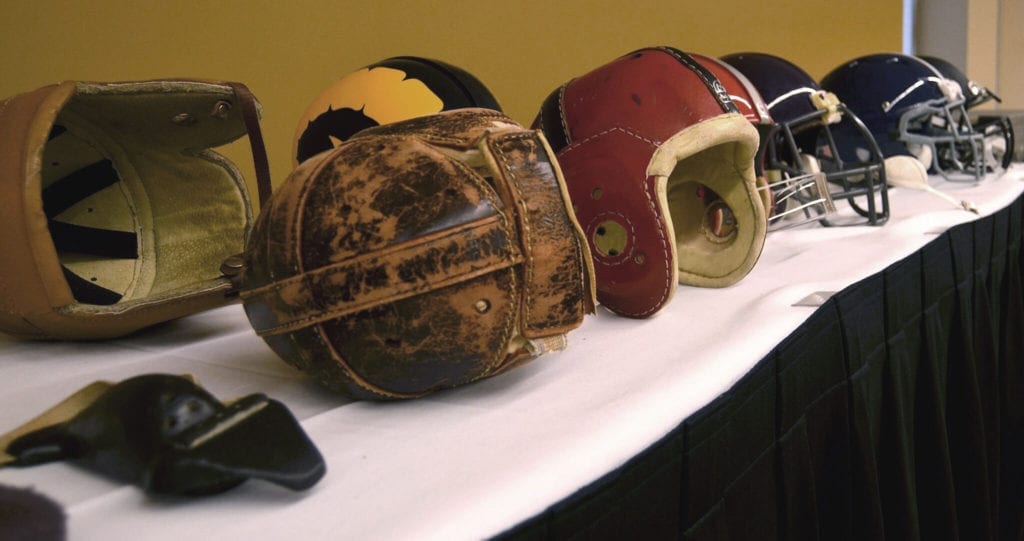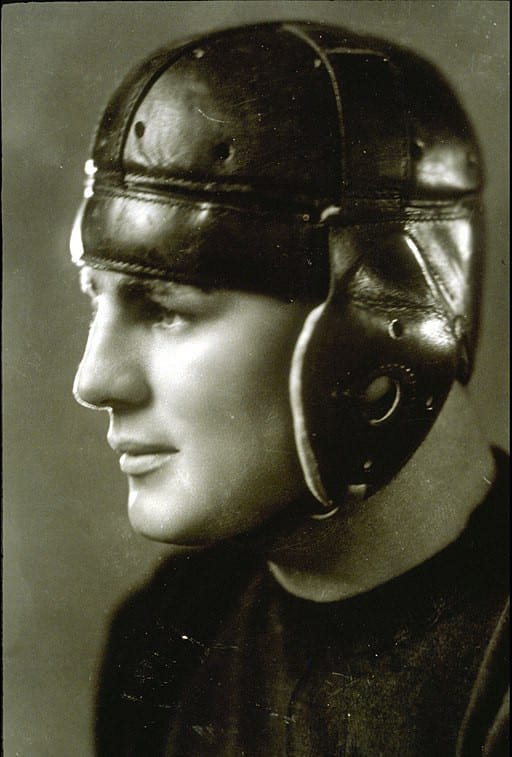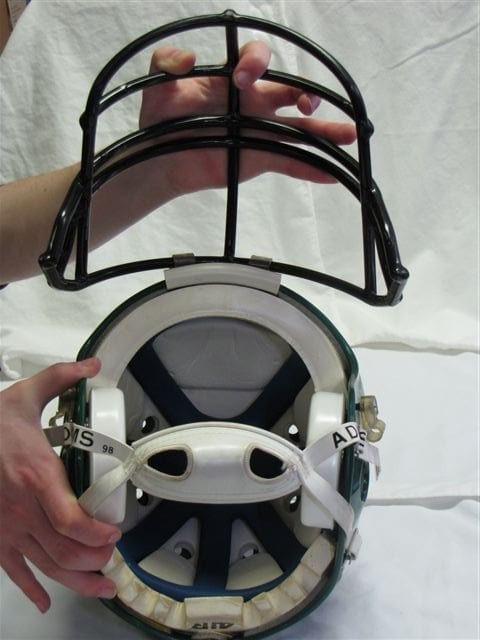| Other than the ball, no other item is more identifiable with football than the helmet. |

Frank MacDonald, Apr. 10th 2020
By Frank MacDonald, Special Contributor to Atavus
As we approach the 150th anniversary of college football in America—Rutgers vs Princeton in 1869--we at Atavus thought it might be interesting to write about some key developments in our favorite game’s history. The following post is the first in a series planned to celebrate 150 years of determination, teamwork, sweat, and joy delivered by the game we love.
Our second post is on the helmet.

Next to the pigskin itself, no piece of equipment is more synonymous with American football than the helmet. Initially an outlier, over the next 125 years it has transitioned from elective to essential, from rudimentary to high-tech and from utilitarian to branding mainstay.
Because it cradles the cranium of each participant, the football helmet is regarded as the key piece of gear in making the sport safer to play. For that reason, advancements and innovations in headgear are being announced with increasing frequency. Yet, as has been proven throughout the sport’s history, rules and equipment are only part of the ultimate equation.

The shiny, sometimes even reflective, helmets of today are a far cry from what was first introduced at the close of the 19th Century.
Then, football was widely considered bloodsport. The 1894 Harvard-Yale game was so brutal that five of the game’s players were taken to the hospital. After sustaining multiple hits to the head, a Midshipman named Joseph Reeve asked an Annapolis cobbler to construct a leather head piece that Reeve could wear in the annual Army-Navy contest. Hardly a helmet, but it was a start.
The first quarter of the 20th Century saw the leather caps, more closely resembling modern-day rugby headgear, begin to catch on. In 1904, there were a reported 18 football deaths across the nation related to skull fractures. New rules were implemented to curb the on-field violence, and the helmet was evolving as well. Soon, featuring a hardened exterior, ventilation, padding and ear holes, the second-generation helmets gradually became more accepted, yet still optional. This was the age of the so-called Leatherheads and the launch of the NFL, in 1920.
Seeking to make the sport still safer, in 1939 college rules made the helmet mandatory and the NFL followed suit four years later. Meanwhile, John T. Riddell was developing the first plastic helmet, featuring an inner liner suspension system that absorbed and better distributed the impact. Not only did NFL teams take notice, so did the U.S. military, which, upon with the endorsement of Major General George Patton, modified it for widespread use by the Army during World War II. Schutt becomes the first to manufacture facemasks.Chin straps were soon added, and by 1949, the plastic model was omnipresent, both among pros and amateurs. Onetime art student and Los Angeles Rams halfback Fred Gehrke started a branding revolution, painting ram horns on an old college helmet. Rams management loved it and commissioned Gehrke to paint all of the team’s headgear. Upon seeing the branded helmets for the first time, a stadium full of Rams fans erupted in a lengthy standing ovation. Continuing throughout the Fifties, virtually every team in America conducted a helmet makeover, adding distinctive colors or an emblem and baking them into the plastic.

Beyond cosmetics, more padding and facemasks were introduced, the latter beginning with a single bar to deter defenders from grabbing or hitting the face. Facemasks soon began expanding to two and three bars, with players wearing them throughout the NFL by 1962. As a result, there were far fewer gouged eyes, broken noses and lost or loosened teeth. Unfortunately, it also created a false air of invincibility. Shoulder tackling began giving way to a more dangerous, head-on approach in which the helmet became a weapon.
With players growing increasingly bigger, stronger and faster, the force exerted in collisions was on the rise. Developers remained devoted to protecting the skull, there was thicker, more effective padding. New types of energy-absorbing cushions and air- or fluid-filled bladders surrounded the head.
The Eighties ushered in a new era of materials and greater engineering detail, making helmets stronger yet lighter, down to about three pounds in some cases. Riddell introduced a rigid polycarbonate alloy shell and vinyl-coated steel alloy facemasks. The Riddell VSR4 was picture perfect, a classic to this day, with circular ear hole and perfectly rounded dome.
Facemasks retreated in size, affording more visibility. To protect their eyes, players began opting to outfit their headpiece with plastic visors. During the 1990s, another function was added to some helmets. Radio transmitters were implanted in quarterbacks’ helmets, allowing coaches to communicate without complicated hand signals or shuttling in messengers.
As football entered a new Millennium, Riddell’s spherical Revo design was intended to reduce concussions. In the last decade, it unveiled a system that records the frequency and severity of impacts to a player’s head during games and practices. More recently, Riddell’s Precision Fit process seeks to further individualize the equipment by using 3D printed helmet liners that will aim to absorb contact and provide more protection.

Schutt’s F7 model features a shell of “Tektonic” plates and cushioning to move independently and a liner that diffuses the force of impact. The Zero1 by Vicis moves the polycarbonate shell inside of a flexible polymer exterior so headgear acts like a car bumper, slowing down the forces. It was rated one of Time Magazine’s top 25 best inventions of 2017.
Some football teams are attempting to further reduce concussion risk. During practice sessions, soft-shell covers are fitted over helmets of players such as linemen, tight ends and linebackers. However, the covers are not approved for use in college or professional games. In collaboration with the NFL Players Association, the NFL has concluded which helmets are acceptable for use in the 2019 season while 11 models that did not meet their safety standards have been banned.
Of course, there are many more players than just those at the NFL and major college level. In early 2019, Virginia Tech researchers ran 17 football helmets through 48 tests that covered both impact locations and velocities. It is the first known independent test data grading the effectiveness of head wear for youth under age 14.
New generations of high-tech, expensive helmets can reduce risk by softening blows. Some of the safer helmets are bigger, heavier and considered, by some, unwieldy. Consequently, some players may reject wearing them. But no amount of science can compete with a more common-sense approach to playing the game. Leagues, coaches and medical personnel must act more decisively to straightaway remove from action those players suspected of having a concussion. Finally, to further reduce the risk of injury, coaches must teach and stress the importance of keeping the head out of the tackle altogether.
To truly create a safer game, more than equipment must be changed. Advancements in tackling technique are the foundation of creating safer and effective tacklers. Shoulder-led tackling that keeps the head out of the tackle is critical is critical in reaching this goal. Atavus aims to create a safer and better game using this approach. Learn more how we make that possible.